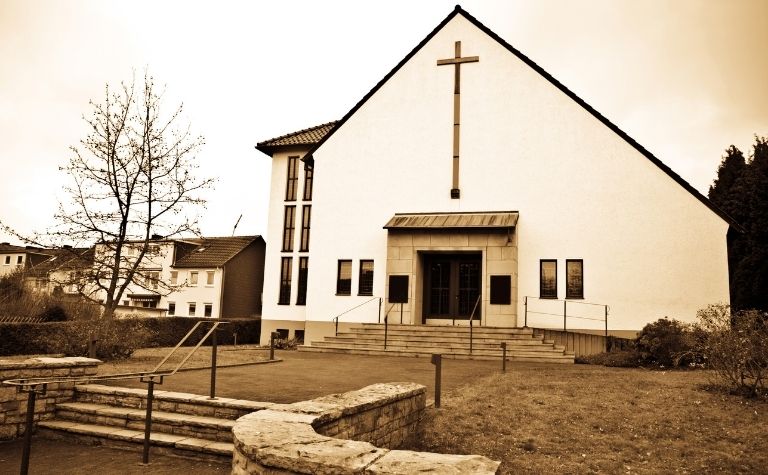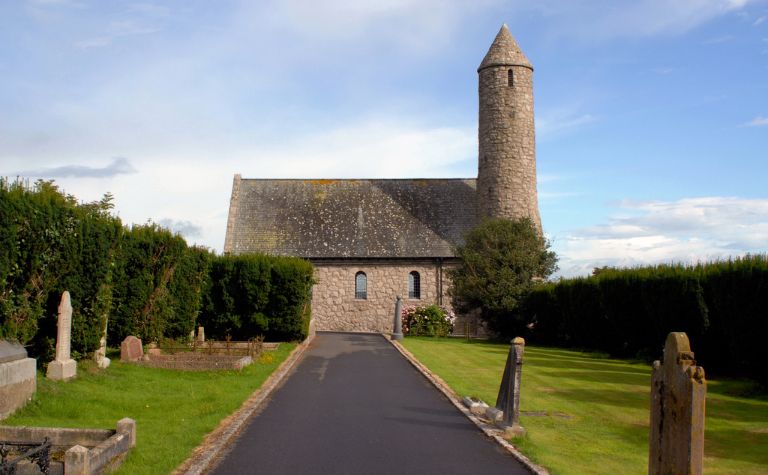Many people know that the terms “Episcopalian” and “Pentecostal” are associated with Christianity, especially in America. There are many similarities between the traditions as they are both Christian, like their belief in the Trinity. Yet, there are important differences in doctrine and practice as well.
The Episcopal Church is the largest denomination in America that belongs to the worldwide Anglican Communion, also called the Church of England. It’s halfway Catholic and halfway Protestant. Pentecostal Christianity is a set of beliefs known for advocating speaking in tongues. It isn’t a denomination per se.
What exactly do the terms “Episcopal” and “Pentecostal” mean? Why do both of these traditions have roots in America? How do their beliefs about the Bible, God, Jesus Christ, and the Holy Spirit compare? Keep reading to learn the answers to these questions and others.
Also, see Episcopalian vs. Roman Catholic: What’s the Difference? to learn more.

Episcopal and Pentecostal Churches: Comparison
Conventionally, the term “Pentecostal” describes a belief system (and accompanying practices) that certain denominations employ, but it’s not a denomination per se.
Some denominations and churches use the term “Pentecostal” in their titles, but those institutions didn’t coin the term.
The Assemblies of God denomination is the largest denomination in America and the world that employs Pentecostal theology.
Yet, there are many others as well, including the International Church of the Foursquare Gospel and the Church of God.
Individual Christians also affirm Pentecostal beliefs and practices and are part of non-Pentecostal denominations. For example, there are Pentecostal Christians in Methodist, Baptist, and Episcopalian churches.
| Pentecostalism | Episcopalian | |
|---|---|---|
| Founded | Historians conventionally date the origin of the modern Pentecostal movement to the Azusa Street Revival in Los Angeles, California, in 1906. Many Pentecostals date their origin to the second chapter of Acts in the New Testament. | The Anglican tradition dates to the time of King Henry VIII (1491-1547) and his protests against the Catholic church. Anglicanism arrived in America with settlers from England. The label “Episcopalian” dates to the time of the Revolutionary War (1775-1783) when the names “Anglican” and “Church of England” were out of favor. |
| Meaning of the name | The word “Pentecostal” comes from the word “Pentecost,” which describes the unique and powerful outpouring of the Holy Spirit upon the early church, as recorded in Acts 2. | From the Greek word for “overseer” and the Latin word for “bishop,” the term refers to a form of church government that locates ecclesiastical authority in the office of bishop as opposed to the papacy or congregational membership. The term also describes the largest tradition in the Anglican communion in America. |
| Branch of Christianity | Pentecostalism is Protestant. Many of the ideas it embraces, like the authority of Scripture, are rooted in the Protestant Reformation, led by Martin Luther of Germany, Ulrich Zwingli of Switzerland, and John Calvin of France. | Because its part of the Anglican Communion, many consider Episcopalianism to be halfway between Protestant and Catholic. Many theologians and historians posit that a church can’t be “halfway Catholic,” so it’s best to consider the tradition Protestant with aspects of Catholicism woven into certain churches. |
| Early influencer(s) | William J. Seymour (1870-1922), Agnes Ozman (1870-1937), Charles Parham (1873-1939) | King Edward VI (1537-1553), Queen Elizabeth I (1533-1603), theologian Richard Hooker (1554-1600) |
| Significant writing outside the Bible | Pentecostalism doesn’t have any literature that is unique to its tradition that is of great significance to the establishment and identity of the movement. It generally values the classic literary works of Protestantism. | Historically, the tradition affirms the Apostles’ Creed and the Nicene Creed. The Book of Common Prayer is also a pivotal document to the heart and identity of the tradition. |
| Organization | Historically, Pentecostalism isn’t a denomination per se but a belief system that certain denominations hold. The largest historic Pentecostal denomination is the Assemblies of God. | The word “episcopal” comes from the Greek word for “overseer” and the Latin word for “bishop.” It refers to a form of church government that locates ecclesiastical authority in the office of bishop as opposed to the papacy, like in Catholicism, or the congregation, like in some Protestant traditions. |
| Divisions | Disagreements between Pentecostals often include the doctrine of perfectionism. Some Pentecostals believe that Christians can grow and mature to the point that they no longer sin in this lifetime. Traditionally, Christian theology has taught that sinless perfection will only occur at death. | The denomination called the “Episcopal Church” is the largest in the tradition by a significant margin. Denominations and churches have split over theological, political, and social issues. Examples of contentious topics include women in ministry, allegations of devaluing Scripture, and issues related to same-sex marriage and gender identification. |
| Theological and Social worldview | Pentecostal denominations and churches tend to be conservative theologically and in relation to social issues. | The “Episcopal Church,” the largest communion in America, is socially and theologically liberal. |
Also, see Episcopalian vs. Anglican: What’s the Difference? to learn more.

Episcopalian and Pentecostal Beliefs: Similarities and Differences
| Episcopalian | Pentecostalism | |
|---|---|---|
| View of the Bible | Historically, Episcopalianism has valued Scripture. Recently, liberal and progressive congregations have decentralized Scripture. People can read deutero-canonical literature or the Apocrypha, but they can’t be used to establish doctrine. | Pentecostals, as Protestants, believe God inspired the biblical authors and that Scripture is singularly authoritative for establishing doctrine. Many conservatives use the term “inerrancy” to describe the nature of the text. |
| View of God | Episcopalians believe in the Trinity; there is one God who exists in three persons. The Father, Son, and Holy Spirit are each fully divine. | Historic Pentecostals are devout Trinitarians. They believe there is one God and that the Father, Son (Jesus Christ), and Holy Spirit are each fully God. |
| View of Christ | Historically, Episcopalianism has affirmed that Jesus is the second person of the Trinity. He is God in human flesh. He is 100% God and 100% man. Jesus was born of a virgin, lived a sinless life, died as an atonement for sin, was physically resurrected on the third day, and ascended into heaven. | Pentecostals believe that Jesus is the second person of the Trinity; they hold to “penal-substitutionary atonement,” which means Jesus’ death paid the price for sin, and on the cross, he took the place of sinners. |
| View of Salvation | Episcopalianism’s roots in Anglicanism are closer to Calvinism than Arminianism. However, Arminianism grew to characterize and influence the tradition more. Today, liberal and progressive congregations are ecumenical and inclusive of other religions, not just other denominations. | Historic Pentecostals are mostly Arminian, although there are some Calvinist or Reformed Christians who believe in the miraculous gifts of the Spirit as well. |

| Episcopalian | Pentecostalism | |
|---|---|---|
| View of the Holy Spirit | The Holy Spirit is the third person of the Trinity. He is fully divine. Episcopalians are historically cessationists (e.g., they don’t speak in tongues), yet some small communions practice charismatic worship (e.g., International Communion of the Charismatic Episcopal Church). | Pentecostals believe the Holy Spirit is the third person of the Trinity. They also believe that all the spiritual gifts mentioned in the New Testament are operational and available for Christians today. This includes speaking in tongues, divine healing, and other miraculous gifts. |
| View of the Ordinances or Sacraments | All Episcopalian expressions recognize baptism and the Lord’s Supper. Those who have convictions that align with the high church recognize the other five that Catholicism does. The Anglican-Episcopalian tradition teaches that the sacraments are a means of grace, as in Catholicism. | Pentecostals, like all Protestants, recognize and practice the two sacraments that Christ himself taught: water baptism and the Lord’s Supper. |
| View of the Lord’s Supper | Christ is present in the elements, but there is a mystery to it. The tradition doesn’t fully embrace Catholicism’s theology of the Eucharist but affirms that consuming the elements is more than simply a memorial practice. | Historic Pentecostals believe the bread and the cup are memorials of Christ’s death. They don’t believe Christ is present in the elements in any way. |
| View of the Baptism | Clergy baptize infants and adults; baptized individuals are “grafted into the church.” | Historic Pentecostals practice “Believer’s Baptism” as opposed to infant baptism. Baptism isn’t necessary for salvation. |
| View of the End Times | Episcopalians believe in the Second Coming of Christ. The tradition’s eschatology is Amillennial, as opposed to Premillennial or Postmilennial. | Historic Pentecostalism is premillennial, meaning it interprets the 1,000-year period described in Revelation 20:1-6 literally. The millennium occurs after the rapture, the seven-year tribulation, and the Second Coming. |
Also, see Episcopalian vs. Methodist: What’s the Difference? to learn more.
Related Questions
Episcopalian and Baptist are two of the largest branches of the Christian faith in America, though churches belonging to each tradition can also be found around the world. Many people know that...
Many people have heard of the Episcopalian and Methodist denominations but don't know the differences and similarities between their respective churches. People may also be aware that both traditions...
